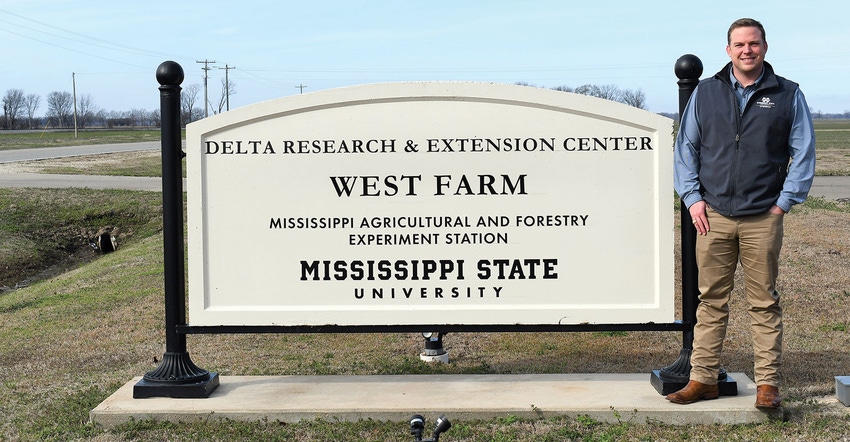
Looking ahead at the coming growing season, Drew Gholson, irrigation specialist at the new National Center for Alluvial Aquifer Research (NCAAR) and Delta Research and Extension Center in Stoneville, Miss., gave a few key ways farmers can improve efficiency in irrigation.
What are the top 3 ways farmers could be more efficient in irrigation on their farms?
"Through the Row-Crop Irrigation Science and Extension Research (RISER) program, an on-farm research and Extension program, we help farmers minimize water use while maintaining or increasing yield and profitability. We set up on farms to put in place irrigation conservation practices, utilizing these three things: computerized hole selection, soil moisture sensors, and surge valves.
"Pipe Planner, a free program, allows you to calculate hole sizes necessary to apply the water uniformly for each furrow at the top end of the field, taking into account pressure losses down the pipe and pumping capacity along with furrow length.
"Ideally, the water from the first to the last furrow will reach the tail ditch at the same time, instead of the ones closest to the well or the shorter rows watering out long before the rest. You have less runoff and wasted water that way. Once you use the free program, it's done, and you have your hole sizes unless these parameters change.
"Soil moisture sensors show the moisture levels and apparent rooting depths in a field. You can irrigate based on moisture levels as opposed to what the crop may look like. Usually, you can hold off watering a little longer based on the soil moisture.
"The deeper the roots are, the more water, potentially, the plant can get. If you irrigate too quickly, the roots are not going to try to find more water because they have enough water on the surface, creating shallow roots.
"Surge valves, due to their timed cycling from one side to the other of a field in the advance phase, can get the water down the row and to the end of the field faster, reducing deep percolation losses and increasing irrigation application uniformity down the row.
"In the timed cycling during the soak phase, water infiltration can be increased while minimizing runoff. Computerized soil selection, soil moisture sensors, and surge valves save water, time, and money as well as increase or maintain yields here in the Delta."
What is one mistake often found in irrigation systems and how do we fix that?
"In furrow irrigation systems, one mistake often made is not managing the system to apply irrigation water uniformly across the field and down the rows while minimizing deep percolation losses and runoff. Use of Pipe Planner can help adjust the set size to complete irrigations in recommended durations, and it can calculate hole size to punch in the poly pipe to distribute the water more uniformly across rows. Surge valves can help apply the water more uniformly down the row while reducing deep percolation losses and minimizing runoff.
"Over-irrigation can occur in both furrow and center pivot irrigation systems as producers push to maximize yields. The use of soil moisture sensors can give more information about the moisture in the soil and the rooting depth of the crop to aid in making better irrigation scheduling decisions to help maximize yield with the least amount of water.
"At crop termination, if you have enough water in your soil for that plant to reach maturity, there's no need for irrigation, so soil moisture sensors can sometimes cut out one or two irrigations."
What are the advantages and disadvantages of center pivot irrigation and furrow irrigation?
"Pivot systems are generally more efficient than furrow irrigation. Using furrow irrigation, you need to use the water as a conveyance system down the furrow to reach the end of the furrow, but it's also the same method of how you're getting the water to the plant, which is one of the main reasons it can be less efficient.
"Center pivots are more efficient generally, but by using those three things I mentioned within the RISER program, computer soil selection, soil moisture sensors, and surge valves, along with better irrigation management, furrow irrigation can become more efficient.
"A trend going on in the Delta indicates more and more farms are using furrow irrigation instead of pivots. From a national standpoint, that's not too common. As a rough estimate, I think, anywhere from around 80% to 85% of the irrigated acres in the Mississippi Delta are furrow irrigated. However, we have pretty level land, so we're able to get evenly distributed water going down the furrow as opposed to areas with rolling hills.
"Also, the Delta has a shallow groundwater table that can have high capacity wells, so we're able to push that water out with high capacity across a field.
"It is more expensive to install a pivot irrigation system than a furrow irrigation system as well, so that is another factor that comes into play. Newer pivots can keep up with the demand better, but the initial cost, as well as the maintenance, are probably the biggest disadvantages."
What are a few things to keep in mind when choosing an irrigation system?
"Every irrigation system is going to be unique to the grower and his land.
"The topography of the land and the soils. Generally, furrow systems are not recommended on fields with high internal drainage (sandy soils) and on rolling fields or fields with steep slopes. On the other hand, fields with heavy clay soils or bottoms that cause issues with pivots getting stuck can be a deterrent to their adoption."
About the Author(s)
You May Also Like




